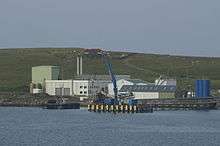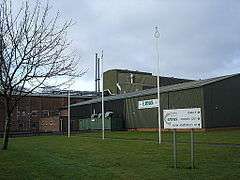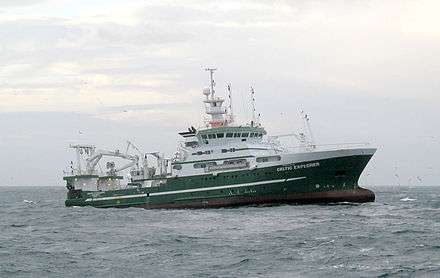Fish meal

Fish meal, or fishmeal, is a commercial product mostly made from fish that are not generally used for human consumption; a small portion is made from the bones and offal left over from processing fish used for human consumption.[1] It is powder or cake obtained by drying the fish or fish trimmings, often after cooking, and then grinding it. If the fish used is a fatty fish it is first pressed to extract most of the fish oil.[1][2]
History
Fish byproducts have been used historically to feed poultry, pigs, and other farmed fish. A primitive form of fishmeal is mentioned in The Travels of Marco Polo at the beginning of the 14th century: 'they accustom their cattle, cows, sheep, camels, and horses to feed upon dried fish, which being regularly served to them, they eat without any sign of dislike.' The use of herring as an industrial raw material started as early as about 800 AD in Norway; a very primitive process of pressing the oil out of herring by means of wooden boards and stones was employed.[2]
Fish used
Fishmeal can be made from almost any type of seafood, but is generally manufactured from wild-caught, small marine fish that contain a high percentage of bones and oil, and are usually deemed not suitable for direct human consumption. The fish caught for fishmeal purposes solely are termed "industrial".[1] Other sources of fishmeal are from bycatch and byproducts of trimmings made during processing (fish waste or offal) of various seafood products destined for direct human consumption.[1]
The main fish sources by country are:[1][2][3]
- Chile: anchovy, horse mackerel
- China: various species
- Denmark: pout, sandeel, sprat
- European Union: pout, capelin, sand eel, and mackerel
- Iceland and Norway: capelin, herring, blue whiting
- Japan: sardine, pilchard, sauries, mackerels
- Peru: anchovies
- South Africa: pilchard
- Thailand: various species
- United States: menhaden, pollock
It takes 4 to 5 tons of fish to produce one ton of fish meal; about 6 million tons of fish are harvested each year solely to make fish meal.[1]
Processing


Fishmeal is made by cooking, pressing, drying, and grinding of fish or fish waste to which no other matter has been added. It is a solid product from which most of the water is removed and some or all of the oil is removed. Four or five tonnes of fish are needed to manufacture one tonne of dry fishmeal.[1]
Of the several ways of making fishmeal from raw fish, the simplest is to let the fish dry out in the sun. This method is still used in some parts of the world where processing plants are not available, but the end product is poor quality in comparison with ones made by modern methods. Now, all industrial fish meal is made by the following processes:[2]
Cooking: A commercial cooker is a long, steam-jacketed cylinder through which the fish are moved by a screw conveyor. This is a critical stage in preparing the fishmeal, as incomplete cooking means the liquid from the fish cannot be pressed out satisfactorily and overcooking makes the material too soft for pressing. No drying occurs in the cooking stage.
Pressing: A perforated tube with increasing pressure is used for this process. This stage involves removing some of the oil and water from the material and the solid is known as press cake. The water content in pressing is reduced from 70% to about 50% and oil is reduced to 4%.
Drying: If the meal is under-dried, moulds or bacteria may grow. If it is over-dried, scorching may occur and this reduces the nutritional value of the meal.
The two main types of dryers are:
- Direct: Very hot air at a temperature of 500 °C (932 °F) is passed over the material as it is tumbled rapidly in a cylindrical drum. This is the quicker method, but heat damage is much more likely if the process is not carefully controlled.
- Indirect: A cylinder containing steam-heated discs is used, which also tumbles the meal.
Grinding: This last step in processing involves the breakdown of any lumps or particles of bone.
Nutrient composition
Any complete diet must contain some protein, but the nutritional value of the protein relates directly to its amino acid composition and digestibility. High-quality fishmeal normally contains between 60% and 72% crude protein by weight. Typical diets for fish may contain from 32% to 45% total protein by weight.[4]
Use
Prior to 1910, fish meal was primarily used as fertilizer, at least in the UK.[2]
Fish meal is primarily used as a protein supplement in compound feed.[2][3] As of 2010, about 56% of fish meal was used to feed farmed fish, about 20% was used in pig feed, about 12% in poultry feed, and about 12% in other uses, which included fertilizer.[1]
The cost of 65% protein fishmeal has varied between around $385 to $554 per ton since 2000, which is about two to three times the price of soybean meal.[1]
The rising demand for fish, as people in the developed world turn away from red meat and toward other sources of meat protein, has increased demand for farmed fish, with farmed fish accounting for half the fish consumed worldwide as of 2016.[5] Demand for fish meal has increased accordingly, but harvests are regulated and supply cannot expand.[1][5] This has led to a trend towards use of other ingredients such as soy meal, cottonseed meal, leftovers from processing from corn and wheat, legumes, and algae, and an increase in research to find alternatives to fish meal and alternate strategic uses (for instance, in the growth phase, after newborn fish are established).[1][5][6]
Risks
Unmodified fish meal can spontaneously combust from heat generated by oxidation of the polyunsaturated fatty acids in the meal. In the past, factory ships have sunk because of such fires. That danger has been eliminated by adding antioxidants to the meal.[1]
As of 2001, ethoxyquin was the most commonly used antioxidant, usually in the range 200–1000 mg/kg.[2] one of the antioxidants that has been used. There has been some speculation that ethoxyquin in pet foods might be responsible for multiple health problems. To date, the U.S. Food and Drug Administration has only found a verifiable connection between ethoxyquin and buildup of protoporphyrin IX in the liver, as well as elevations in liver-related enzymes in some animals, but with no known health consequences from these effects. In 1997, the Center for Veterinary Medicine asked pet food manufacturers to voluntarily limit ethoxyquin levels to 75 ppm until further evidence is reported. However, most pet foods that contain ethoxyquin have never exceeded this amount. Ethoxyquin has been shown to be slightly toxic to fish.
Though it has been approved for use in foods in the US, and as a spray insecticide for fruits, ethoxyquin has surprisingly not been thoroughly tested for its carcinogenic potential. Ethoxyquin has long been suggested to be a possible carcinogen, and a very closely related chemical, 1,2-dihydro-2,2,4-trimethylquinoline, has been shown to have carcinogenic activity in rats, and a potential for carcinogenic effect to fishmeal prior to storage or transportation.
See also
References
- 1 2 3 4 5 6 7 8 9 10 11 12 R. D. Miles and F. A. Chapman. FA122: The Benefits of Fish Meal in Aquaculture Diets Fisheries and Aquatic Sciences Department, UF/IFAS Extension. Original publication date November 2005. Reviewed January 2015.
- 1 2 3 4 5 6 7 M. L. Windsor for the UK Department of Trade and Industry, Torry Research Station. Fish meal. Torry Advisory Note No. 49 Published by FAO in partnership with Support unit for International Fisheries and Aquatic Research, SIFAR, 2001) Bibliographical information from FAO index page
- 1 2 Tim Cashion from Sea Around Us. The end use of marine fisheries landings Fisheries Centre Research Reports, 2016
- ↑ "Manufacture, Storage, Composition And Use Of Fish Meal".
- 1 2 3 Fry JP, et al. Environmental health impacts of feeding crops to farmed fish. Environ Int. 2016 May;91:201-14. Review. PMID 26970884 Free full text
- ↑ NOAA NOAA-USDA Alternative Feeds Initiative page accessed June 3, 2016

